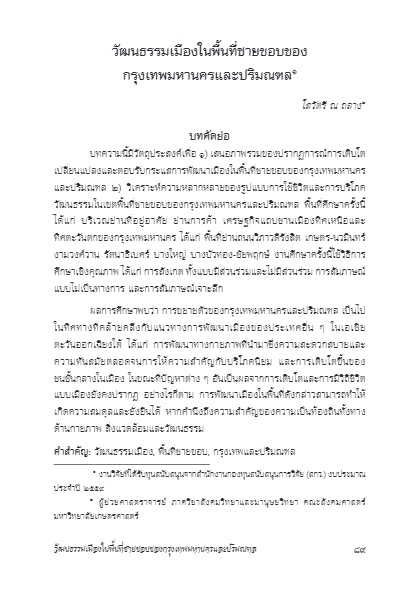โสวัตรี ณ ถลาง
บทคัดย่อ
บทความนี้มีวัตถุประสงค์เพื่อ 1) เสนอภาพรวมของปรากฏการณ์การเติบโต เปลี่ยนแปลงและตอบรับกระแสการพัฒนาเมืองในพื้นที่ชายขอบของกรุงเทพมหานครและปริมณฑล 2) วิเคราะห์ความหลากหลายของรูปแบบการใช้ชีวิตและการบริโภควัฒนธรรมในเขตพื้นที่ชายขอบของกรุงเทพมหานครและปริมณฑล พื้นที่ศึกษาครั้งนี้ ได้แก่ บริเวณย่านที่อยู่อาศัย ย่านการค้า เศรษฐกิจแถบชานเมืองทิศเหนือและทิศตะวันตกของกรุงเทพมหานคร ได้แก่ พื้นที่ย่านถนนวิภาวดีรังสิต เกษตร-นวมินทร์ งามวงศ์วาน รัตนาธิเบศร์ บางใหญ่ บางบัวทอง-ชัยพฤกษ์ งานศึกษาครั้งนี้ใช้วิธีการศึกษาเชิงคุณภาพ ได้แก่ การสังเกต ทั้งแบบมีส่วนร่วมและไม่มีส่วนร่วม การสัมภาษณ์แบบไม่เป็นทางการ และการสัมภาษณ์เจาะลึก
ผลการศึกษาพบว่า การขยายตัวของกรุงเทพมหานครและปริมณฑล เป็นไปในทิศทางที่คล้ายคลึงกับแนวทางการพัฒนาเมืองของประเทศอื่น ๆ ในเอเชียตะวันออกเฉียงใต้ ได้แก่ การพัฒนาทางกายภาพที่นำมาซึ่งความสะดวกสบายและความทันสมัยตลอดจนการให้ความสำคัญกับบริโภคนิยม และการเติบโตขึ้นของชนชั้นกลางในเมือง ในขณะที่ปัญหาต่าง ๆ อันเป็นผลจากการเติบโตและการมีวิถีชีวิตแบบเมืองยังคงปรากฏ อย่างไรก็ตาม การพัฒนาเมืองในพื้นที่ดังกล่าวสามารถทำให้เกิดความสมดุลและยั่งยืนได้ หากคำนึงถึงความสำคัญของความเป็นท้องถิ่นทั้งทางด้านกายภาพ สิ่งแวดล้อมและวัฒนธรรม
คำสำคัญ : วัฒนธรรมเมือง, พื้นที่ชายขอบ, กรุงเทพและปริมณฑล
(ตีพิมพ์ใน วารสารไทยศึกษา ปีที่ 14 ฉบับที่ 2 (กรกฎาคม – ธันวาคม 2561) หน้า 89-123)
Urban Culture in the Marginal Areas of Bangkok and the Periphery
Sowatree Nathalang
Abstract
The purposes of this article are 1) to present holistically urban growth and changes relevant to current urban development in the marginal areas of Bangkok and the periphery and 2) to analyze the diversity of people’s pattern of life and cultural consumption in such areas. The area of this study includes residential, economic and commercial areas located in the northern and western part of Bangkok, i.e Vipawadee Rangsit, Kaset-Nawamin, Ngamwongwan, Rattanaitbet, Bang Yai and Bangbuathong-Chaiyapreuk junctions. A qualitative method, including participant and non-participant non-formal and in-depth interviews, was used.
The study reveals that the expansion of Bangkok and the periphery is relevant to the trend of urban development in Southeast Asian countries. Such physical development leads to comfort and modernity, including concentration of consumerism and the increase of the urban middle class; whereas diverse problems caused by urban growth and urbanism as a way of life still persist. However, urban development in such areas could be balanced and sustainable if localism in physical, environmental and cultural aspects is stressed.
Keywords : urban culture, marginal area, Bangkok and periphery
(Published in Journal of Thai Studies Volume 14 Number 2 (July – December 2018) Page 89-123)
บทความ / Full Text : Download
